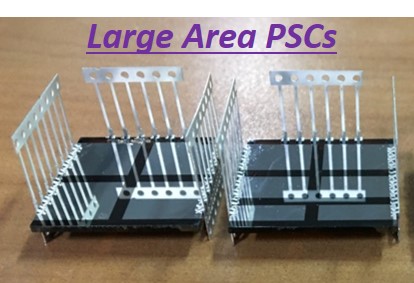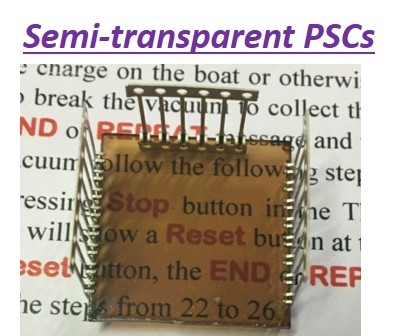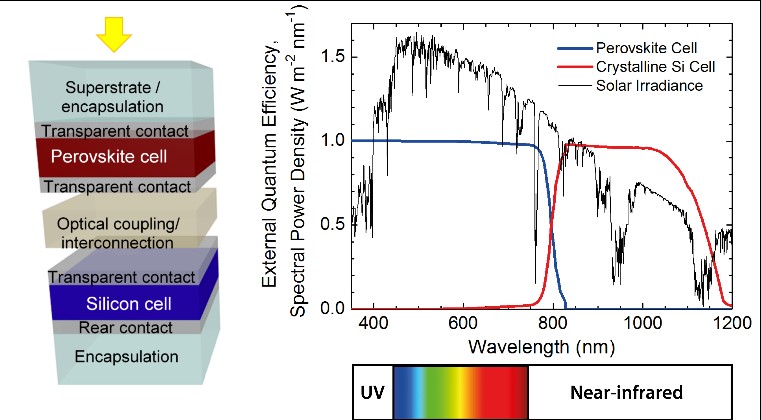Research and Facilities
Below is a brief video showing the research equipment available in the various facilities.
We have the following areas of interest:
Organic solar cells have reached a record high efficiency of 16%, therefore, it is very important to explore the device physics by understanding charge generation, charge transport and voltage losses. Our work focusses on micro-spectroscopic and micro-structural investigation of organic solar cells based on fullerene as well as non-fullerene acceptors. Some of the experiments include device fabrication and characterization, atomic force microscopy, scanning photocurrent microscopy and low temperature J-V, photoluminescence and electroluminescence spectroscopy.
The performance of bulk heterojunction (BHJ) organic solar cells (OSCs) strongly depends on the intermolecular packing of donor:acceptor (D:A) molecules, as it directly influences the photo-physics and charge transfer properties of the blend, in particular open circuit voltage.
Solar cells based on halide perovskite are currently the fastest-growing photovoltaic (PV) technology in terms of research and development. We are working on fabrication of semi-transparent perovskite solar cells in order to make Si-Perovskite and organic-perovskite tandem solar cells. The major challenges in perovskite community are toxicity, stability and scalability. We are replacing Pb by Sn in order to make environment friendly solar cells (PCE~8%) and goal is to extend it with an active area of 1 cm2. We also study the charge transport length scales, recombination dynamics and emission kinetics in perovskite solar cells and thin films.
We conduct investigations of nanostructured transparent conducting electrodes and their application for optoelectronic devices along with the modification of electron transport layer for high efficiency perovskite solar cell.
Transparent conducting electrodes and transparent conducting oxides have a vital role in terms of charge extraction and injection in optoelectronics and energy devices. To fabricate the transparent devices for the tandem and individual applications, it is required to replace the opaque electrode with a transparent electrode for the desired wavelength of the spectrum. We are particularly interested in the fabrication of semitransparent perovskite and the organic solar cell to make them tandem with each other and with Si-based solar cell to cross the maximum efficiency limit. Nature inspired nanowire-based electrode and sputter damage free TCO deposition is another field of interest. Development of effective charge transport layer is one of the area of work for us. Here, we are trying to deposit the charge transport layer on a large area with uniformity using both chemical and physical methods. We are also using different spectroscopy techniques combined with electrical measurements to explore the device science of these energy and optoelectronics devices.
We also fabricate Perovskite solar cells by adopting alternative annealing methods. Energy alignment of interfacial layers and recombination dynamics of these layers for better carrier collection have been studied. Keeping in mind these aspects, compositionally engineered perovskite absorber layers are under development.
 |
| 


In the last few years, Hybrid organic-inorganic perovskites have made tremendous progress, with record efficiencies beyond 23.3%. Interestingly, perovskite cells are not only very efficient, but also have a high and tunable band gap which covers entire visible range. It is therefore useful to combine perovskite top-cells with silicon bottom-cells, which primarily harvest near infrared light. Therefore, our primary goals is to develop semitransparent perovskite solar cells that can be deposited on top of silicon solar cells to make tandems.

Searching for the physics behind high-efficiency organic light emitting diodes. Understanding the system is equally important as improving the efficiency and stability of optoelectronics devices. We also study triplet diffusion in high TTA sensitive materials, scattering effects in the device outcoupling, and magnetic field effects using advanced experimental techniques such as molecular spectroscopy.
In my research I am trying to understand the physics behind performance efficiency of polyfluorene based organic light emitting diodes (OLED). I use molecular spectroscopy and study photophysics of organic semiconductors to improve the device performance. I am also looking forward to learn advanced spectroscopic and characterization techniques like Fluorescence Correlation Spectroscopy, Atomic Force Microscopy etc.
Field Effect Transistors with Organic semiconductors (OFETs), integrated with optoelectronics can enable complete device systems on inexpensive lightweight flexible substrates. Charge transport occurs by mechanisms quite different from those observed in conventional silicon based devices. We study these mechanisms with an aim to arrive at and find ways to tune the parameters related to materials and interfaces in OFETs that are crucial to enhancing charge transport and hence device performance.
We are interested in photo-physical studies to understand the energy transfer dynamics between the two species in compound halide pervoskite emitter thin films and nano-crystals. We are also interested in their application in light emitting devices.